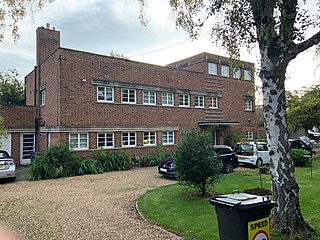
Ieoh Ming Pei was a Chinese-American architect. Raised in Shanghai, Pei drew inspiration at an early age from the garden villas at Suzhou, the traditional retreat of the scholar-gentry to which his family belonged. In 1935, he moved to the United States and enrolled in the University of Pennsylvania's architecture school, but he quickly transferred to the Massachusetts Institute of Technology. He was unhappy with the focus at both schools on Beaux-Arts architecture, and spent his free time researching emerging architects, especially Le Corbusier. After graduating, he joined the Harvard Graduate School of Design (GSD) and became a friend of the Bauhaus architects Walter Gropius and Marcel Breuer. In 1948, Pei was recruited by New York City real estate magnate William Zeckendorf, for whom he worked for seven years before establishing an independent design firm in 1955, I. M. Pei & Associates. In 1966 that became I. M. Pei & Partners, and in 1989 became Pei Cobb Freed & Partners. Pei retired from full-time practice in 1990. In his retirement, he worked as an architectural consultant primarily from his sons' architectural firm Pei Partnership Architects.

William Butterfield was a Gothic Revival architect and associated with the Oxford Movement. He is noted for his use of polychromy.

Modern architecture, or modernist architecture, was an architectural movement or architectural style based upon new and innovative technologies of construction, particularly the use of glass, steel, and reinforced concrete; the idea that form should follow function (functionalism); an embrace of minimalism; and a rejection of ornament. It emerged in the first half of the 20th century and became dominant after World War II until the 1980s, when it was gradually replaced as the principal style for institutional and corporate buildings by postmodern architecture.
The year 1935 in architecture involved some significant architectural events and new buildings.
The year 2003 in architecture involved some significant architectural events and new buildings.

Boyton is a village and civil parish in Wiltshire, England. It lies in the Wylye Valley within Salisbury Plain, about 6 miles (10 km) south-east of Warminster and 13 miles (21 km) north-west of Salisbury. The parish includes the village of Corton.

The Georgian Group is a British charity, and the national authority on Georgian architecture built between 1700 and 1837 in England and Wales. As one of the National Amenity Societies, The Georgian Group is a statutory consultee on alterations to listed buildings, and by law must be notified of any work to a relevant listed building which involves any element of demolition.

The Suzhou Museum is a museum of ancient Chinese art, paintings, calligraphy and handmade crafts in Suzhou, Jiangsu, China. It is one of the most visited museums in the world, with 2,340,000 visitors in 2018. The Folk Branch of the museum is at the Bei family ancestral temple near Lion Grove Garden.

Thomas Henry Wyatt was an Anglo-Irish architect. He had a prolific and distinguished career, being elected President of the Royal Institute of British Architects 1870–73 and being awarded its Royal Gold Medal for Architecture in 1873. His reputation during his lifetime was largely as a safe establishment figure, and critical assessment has been less favourable more recently, particularly in comparison with his younger brother, the better known Matthew Digby Wyatt.

Oare is a small village in the east of the county of Wiltshire, England. The village lies about 2 miles (3.2 km) north of Pewsey, on the A345 road towards Marlborough, and falls within the civil parish of Wilcot, Huish and Oare.

Chinese Garden is a park in Jurong East, Singapore. Built in 1975 by the JTC Corporation and designed by Prof. Yuen-chen Yu, an architect from Taiwan, the Chinese Garden's concept is based on Chinese gardening art. The main characteristic is the integration of architectural features with the natural environment. The Chinese Garden is modeled along the northern Chinese imperial style of architecture and landscaping. It is located next to Chinese Garden MRT station and connected to the adjacent Japanese Garden by a bridge. Along with Japanese Garden, the two gardens are collectively known as the Jurong Gardens.

Ferne House is a country house in the parish of Donhead St Andrew in Wiltshire, England, owned by Viscount Rothermere.

Lucknam Park is a luxury hotel, spa and restaurant in west Wiltshire, England, about 3 miles (5 km) north-west of Corsham and 7 miles (11 km) north-east of Bath. The core of its building is a Grade II listed country house built in the late 17th or early 18th century. The hotel's restaurant has held one star in the Michelin Guide since 2006.
Bridget Cherry OBE, FSA, Hon. FRIBA is a British architectural historian who was series editor of the Pevsner Architectural Guides from 1971 until 2002, and is the author or co-author of several volumes in the series.
Philip Dalton Hepworth was a British architect. He studied in both the UK and France, at the Architectural Association School of Architecture and the École des Beaux-Arts, and returned to work as an architect after serving in the First World War. He rose to prominence in the 1930s, featuring in a book by architectural critic Trystan Edwards and winning the commission in 1932 to design Walthamstow Town Hall, which was eventually completed in 1942. Another civic building of this period was Wiltshire County Hall at Trowbridge. He also designed a handful of private houses, including Pemberley, in Loughton, 1936. He lived in Zoffany House in Strand-on-the-Green, Chiswick, London, from 1936.

Oare House is a Grade I listed country house in Oare, Wiltshire, England.

The Hall, at times known as Kingston House and The Duke's House, is a Grade I listed Jacobean mansion in Bradford-on-Avon, Wiltshire, England.

31 Madingley Road is a Modernist red-brick house in Madingley Road, west Cambridge, England, designed by Marshall Sisson for the classical archaeologist A. W. Lawrence in 1931–32. It is one of the first Modernist-style houses in Cambridge, and is listed at grade II.
Doris Morley Cosens, often referred to as Dora Cosens, was a British architect, particularly known for her Modernist house, 9 Wilberforce Road in Cambridge. Along with Mary Crowley and Elisabeth Scott, she was among the earliest women architects to work in Britain during the modern era.

Modern: The Modern Movement in Britain is a non-fiction book by Alan Powers, first published in 2005 by Merrell, about Modernism in British architecture, mainly focusing on the period between 1930 and 1940. The bulk of the book is a gazetteer of 60 architects or architectural practices, including both famous figures and lesser-known ones. The book received broadly positive reviews, with its wide coverage, and particularly its strong coverage of women architects of the period, being generally appreciated. Some reviewers criticise the inclusion of modern buildings lying outside the definition of Modernist. A further critique is that the analysis lacks depth. The book is illustrated with colour photographs by Morley von Sternberg.















